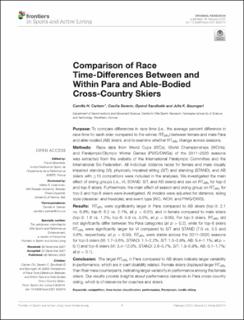| dc.description.abstract | Purpose: To compare differences in race time (i.e., the average percent difference in race time for each skier compared to the winner, RTdiffs) between female and male Para and able-bodied (AB) skiers, and to examine whether RTdiffs change across seasons.
Methods: Race data from World Cups (WCs), World Championships (WCHs), and Paralympic/Olympic Winter Games (PWG/OWGs) of the 2011–2020 seasons was extracted from the website of the International Paralympic Committee and the International Ski Federation. All individual distance races for female and male visually impaired standing (VI), physically impaired sitting (SIT) and standing (STAND), and AB skiers with ≥10 competitors were included in the analyses. We investigated the main effect of skiing groups (i.e., VI, STAND, SIT, and AB skiers) and sex on RTdiffs for top-3 and top-8 skiers. Furthermore, the main effect of season and skiing group on RTdiffs for top-3 and top-8 skiers were investigated. All models were adjusted for distance, skiing style (classical- and freestyle), and event type (WC, WCH, and PWG/OWG).
Results: RTdiffs were significantly larger in Para compared to AB skiers (top-3: 2.1 vs. 0.9%; top-8: 6.2 vs. 2.1%, all p < 0.01), and in female compared to male skiers (top-3: 1.8 vs. 1.3%; top-8: 4.9 vs. 3.5%, all p < 0.05). For top-3 skiers, RTdiffs did not significantly differ between the Para categories (all p > 0.2), while for top-8 skiers RTdiffs were significantly larger for VI compared to SIT and STAND (7.0 vs. 5.5 and 5.6%, respectively, all p < 0.05). RTdiffs were stable across the 2011–2020 seasons for top-3 skiers (VI: 1.7–3.6%, STAND: 1.1–2.2%, SIT: 1.0–3.9%, AB: 0.4–1.1%; all p > 0.1) and top-8 skiers (VI: 3.4–12.0%, STAND: 2.6–5.7%, SIT: 1.9–5.9%, AB: 0.1–1.7%; all p > 0.1).
Conclusion: The larger RTdiffs in Para compared to AB skiers indicate larger variability in performance, which are in part disability related. Female skiers displayed larger RTdiffs than their male counterparts, indicating larger variability in performance among the female skiers. Our results provide insights about performance demands in Para cross-country skiing, which is of relevance for coaches and skiers. | en_US |

